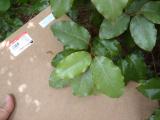Sign up for the iWire to get breaking news, events and the species spotlight.
Go Back | Printer Friendly Fact Sheet
Elaeagnus angustifolia
Russian olive
Synonym(s):
Family: Elaeagnaceae (Oleaster Family)
Duration and Habit: Perennial Shrub

Photographer: James H. Miller
Source: USDA Forest Service, Bugwood.org
Description
Introduced shrub or small tree often with crooked or leaning trunk, dense crown of low branches, silvery foliage, and sometimes spiny twigs. Height: 20' (6 m). Diameter: 4" (10 cm). Leaves: 1 1/2-3 1/4" (4-8 cm) long, 3/8-3/4" (10-19 mm) wide. Lance-shaped or oblong; without teeth; short-stalked. Dull gray-green with obscure veins above, silvery, scaly, and brown-dotted beneath. Bark: gray-brown; thin, fissured and shedding in long strips. Twigs: silvery, scaly when young, becoming reddish-brown; long and slender; often ending in short spine. Flowers: 3/8" (10 mm) long; bell-shaped; with 4 calyx lobes, yellow inside, silvery outside (petals absent); fragrant; short-stalked; scattered along twigs at leaf bases; in late spring or early summer. Fruit: 3/8-1/2" (10-12 mm) long; berrylike, elliptical,yellow to brown with silvery scales, becoming shiny; thin, yellow, mealy, sweet edible pulp; large brown stone; scattered along twig; maturing in late summer and autumn.
Ecological Threat: Russian-olive can outcompete native vegetation, interfere with natural plant succession and nutrient cycling, and tax water reserves. Because Russian-olive is capable of fixing nitrogen in its roots, it can grow on bare, mineral substrates and dominate riparian vegetation where overstory cottonwoods have died. Although Russian-olive provides a plentiful source of edible fruits for birds, ecologists have found that bird species richness is actually higher in riparian areas dominated by native vegetation.
Biology & Spread: Establishment and reproduction of Russian-olive is by primarily by seed, although some vegetative propagation also occurs. The fruit of Russian-olive is a small cherry-like drupe that is readily eaten and disseminated by many species of birds.
History: Native to Europe and western Asia, a recent (early 1900s) arrival in the upper part of the Southeast. Initially planted as a yard ornamental, for windbreaks, surface mine reclamation, and wildlife habitat.
US Habitat: Found as scattered plants in forest openings, open forests, and along forest edges. Thrives in sandy floodplains. Shade intolerant. Spreads by bird- and other animal-dispersed seeds. A nonleguminous nitrogen fixer.
Distribution
US Nativity: Introduced to U.S.
Native Origin: Temp. & trop. Asia, Europe (Germplasm Resources Information Network); NatureServe Explorer
US States: AZ, CA, CO, CT, IA, ID, IL, KS, KY, MA, MD, ME, MI, MN, MO, MT, ND, NE, NJ, NM, NV, NY, OH, OK, OR, PA, RI, SD, TN, TX, UT, VA, WA, WI, WY
Mapping
Invaders of Texas Map: Elaeagnus angustifolia
EDDMapS: Elaeagnus angustifolia
USDA Plants Texas County Map: Elaeagnus angustifolia
Invaders of Texas Observations
List All Observations of Elaeagnus angustifolia reported by Citizen Scientists
Resembles/Alternatives
When restoring areas previously infested with Russian-olive, use shrub and tree species native to the particular region and ecosystem. Native plants provide the choicest shelter and food for wildlife.
- Diospyros texana (Texas persimmon)
- Chilopsis linearis (desert willow)
- Baccharis neglecta (Rooseveltweed)
- Prunus caroliniana (Carolina laurelcherry)
- Lindera benzoin (northern spicebush)
- Hamamelis virginiana (American witchhazel)
- Asimina triloba (pawpaw)
- Cornus florida (flowering dogwood)
- Euonymus americanus (bursting-heart)
- Viburnum dentatum (southern arrowwood)
Management
Mowing hedges with a brush type mower, followed by removal of cut material may be the most effective method for eradication. Herbivorous animals are not known to feed on it and few insects seem to utilize or bother it. Canker disease is occasionally a problem but not enough to be useful as a control agent.
USE PESTICIDES WISELY: ALWAYS READ THE ENTIRE PESTICIDE LABEL CAREFULLY, FOLLOW ALL MIXING AND APPLICATION INSTRUCTIONS AND WEAR ALL RECOMMENDED PERSONAL PROTECTIVE GEAR AND CLOTHING. CONTACT YOUR STATE DEPARTMENT OF AGRICULTURE FOR ANY ADDITIONAL PESTICIDE USE REQUIREMENTS, RESTRICTIONS OR RECOMMENDATIONS. MENTION OF PESTICIDE PRODUCTS ON THIS WEB SITE DOES NOT CONSTITUTE ENDORSEMENT OF ANY MATERIAL.SEARCH Online
Google Search: Elaeagnus angustifolia
Google Images: Elaeagnus angustifolia
NatureServe Explorer: Elaeagnus angustifolia
USDA Plants: Elaeagnus angustifolia
Invasive Plant Atlas of the United States: Elaeagnus angustifolia
Bugwood Network Images: Elaeagnus angustifolia
Text References
Knopf, F.L., and T.E. Olson. 1984. Naturalization of Russian-olive: implications for Rocky Mountain wildlife. Wildlife Society Bulletin 12:289-298.
Shafroth, P.R., G.T. Aubla, and M.L. Scott. 1995. Germination and establishment of the native plains cottonwood (Populus deltoides Marshall subsp. moniifera) and the exotic Russian-olive (Elaeagnus angustifolia L.). Conservation Biology 9:1169-1175.
Data Source
APWG WeedUS Database
Miller, J.H. 2003. Nonnative invasive plants of southern forests: a field guide for identification and control. Gen. Tech. Rep. SRS-62. Asheville, NC: U.S. Department of Agriculture, Forest Service, Southern Research Station. 93 pp (USDA SRS).











